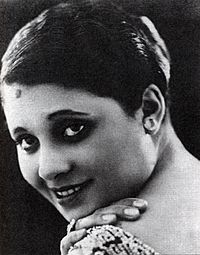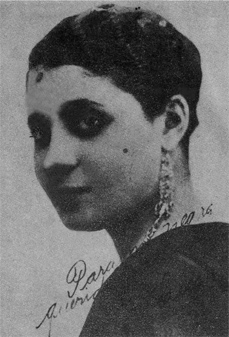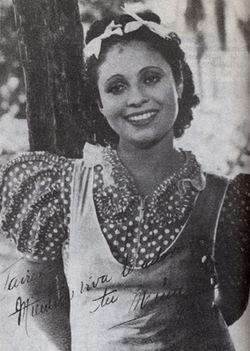Rita Montaner facts for kids
Quick facts for kids
Rita Montaner
|
|
|---|---|

Rita Montaner
|
|
| Background information | |
| Birth name | Rita Aurelia Fulcida Montaner y Facenda |
| Also known as | Rita de Cuba |
| Born | 20 August 1900 Guanabacoa, Cuba |
| Died | 17 April 1958 (aged 57) Havana, Cuba |
| Genres | Rhumba, zarzuela |
| Occupation(s) | Musician, actress |
| Instruments | Vocals, piano |
| Years active | 1920–1958 |
| Labels | Puchito |
| Associated acts | Bola de Nieve, Ernesto Lecuona, Juana Bacallao |
Rita Aurelia Fulcida Montaner y Facenda (born August 20, 1900 – died April 17, 1958) was a famous Cuban singer, pianist, and actress. She was known as Rita Montaner or Rita de Cuba. People called her a vedette, which means a big star, especially in cabaret shows.
Rita Montaner was very popular in cities like Mexico City, Paris, Miami, and New York. She performed, made movies, and recorded music there. She was one of Cuba's most loved artists from the late 1920s to the 1950s. Rita was trained to sing classical music, especially for zarzuelas (Spanish musical plays). But she became famous for singing Afro-Cuban salon songs. Some of her most famous songs include "The Peanut Vendor" and "Siboney".
Throughout her career, Rita Montaner worked closely with two other famous musicians from her hometown of Guanabacoa. These were the pianist and singer Bola de Nieve and the composer Ernesto Lecuona.
Contents
Discovering Rita Montaner's Early Life
Rita Montaner was born on August 20, 1900, in Guanabacoa, Havana, Cuba. Her family was middle-class. Her father, Domingo Montaner Pulgarón, was a pharmacist. Her mother was Mercedes Facenda. Rita was a smart and attractive person with a lovely smile.
She learned English, Italian, and French at a religious school. At age 10, she started studying music at the Peyrellade Conservatory in Havana. There, she learned about solfege (singing notes), music theory, harmony, and piano. When she was 16, she began voice lessons.
Rita showed great talent from a young age. She got her first mention in the newspaper in 1912. Her first photo in the press appeared in 1913. In 1915, she won two bronze medals for her piano playing. In 1917, Rita Montaner played music by Mendelssohn for her final exam. She graduated from the conservatory with a gold medal in piano, singing, and harmony.
Rita Montaner was married and had two sons, Rolando and Alberto. She passed away from cancer in 1958 when she was 57 years old.
Exploring Rita Montaner's Career
Starting Her Musical Journey
Rita Montaner's career officially began in March 1922. She performed at a concert of Cuban music in Havana. This event was organized by composer Eduardo Sánchez de Fuentes, a friend of her family. He convinced her husband to let her sing on stage. In October 1922, she sang on one of the first radio broadcasts in Cuba at the PWX radio station.
By 1923, Rita had a busy schedule as a professional performer. She sang duets with Eusebio Delfín. She also performed solo songs by famous composers like Alberto Villalón, Ernesto Lecuona, and Sánchez de Fuentes. She even sang a duet from the opera La Gioconda with another soprano, Lola de la Torre.
Her early work with maestros like Lecuona, Jorge Anckermann, and Gonzalo Roig was very successful. It was also considered very respectable for a married woman at that time. However, Rita's desire to perform in public grew stronger. This was not always easy to balance with her family life.
In 1926, Rita sang on stage with Lecuona playing the piano. This was at his 7th Concert of Cuban music at the Teatro Nacional. Later that year, she went to New York. After recovering from an operation, she performed at a charity concert. She then got a contract with the Schubert brothers, who were important show producers. She made her debut in the Schubert Follies at the Apollo Theater. She also had a big hit with a show called A night in Spain.
Back in Havana in 1927, she started performing in zarzuelas. In La Niña Rita, o La Habana de 1830, she sang the famous Congo-tango "Mamá Inés". In another show, Lecuona's La tierra de Venus, Rita sang "Siboney". This song is still a popular Latin standard today.
Rising to Stardom
From 1927 to 1929, Rita Montaner recorded about fifty songs for Columbia Records. These included hits from her shows like "Ay, Mama Inés," "Siboney," and the first recording of "El manisero" (The Peanut Vendor). She traveled to Paris for the first time. There, she performed at famous theaters like the Olympia and Le Palace. She also appeared in Josephine Baker's show.
In 1929, Rita traveled to Madrid and Valencia in Spain, then back to Paris. She returned to Cuba in 1930. In 1931, she went to Broadway in New York. She was hired by Al Jolson for his musical Wonder Bar, which was set in a Paris nightclub. Rita was perfect for this role. When she was in Cuba, Rita often performed at the Edén Concert, a popular nightclub in Havana.
In 1933, she went to Mexico City with Bola de Nieve as her piano player. Rita helped him become famous by putting his nickname on the show's bill. Her shows in Mexico were very successful.
When movies started to have sound, new chances opened up for musicians. Rita Montaner began a new career as a film actress. After singing in a 1934 film, she made two more movies in 1938. Radio also became very popular, and Rita used this new medium to share her musical talent. However, her strong personality sometimes caused problems.
Shining on Radio and in Nightclubs
In 1942, Rita had her own radio show called Yo no sé nada (I don't know anything!). She played a character called La Chismosa (The Gossip). Later, in 1946, she had another radio show called Mejor que me calle (Better I shut up!). In this show, she played a street character named Lengualisa. The program was very popular and continued until 1948.
Rita Montaner was also known for helping people. She helped Rodrigo Neira, a choreographer who became ill. She saved him from a special hospital, supported his family, and gave him a place to live. She also helped Chano Pozo, a famous musician, before he became well-known. She got him a job at a radio company.
In 1939, the famous Tropicana cabaret opened in Marianao, Havana. After closing during the war, the Tropicana reopened in 1945. In 1946, Rita Montaner signed a contract with the Tropicana. She performed there for almost four years, which was her longest contract. Mongo Santamaría, another famous musician, said that this started the era of big Cuban cabaret shows.
Acting in the 1950s
Rita Montaner continued to perform in theater when her radio show was not on air. In 1955, she was very successful in the opera La Medium. In 1956, she starred in the comedy Mi querido Charles. From 1954, she also appeared in a comedy TV show called Rita y Willy with Guillermo Alvarez Guedes. In the late 1940s and early 1950s, she acted in many Mexican movies. These films were part of a genre called Rumberas.
Filmography
These are the films Rita Montaner appeared in as an actress, singer, or pianist.
- 1934 La noche del pecado (Mexican)
- 1938 Sucedió en La Habana
- 1938 El romance del palmar
- 1947 María la O (co-production Cuba/Mexico)
- 1948 Los angelitos negros (Mexican)
- 1950 Ritmos del Caribe (Mexican)
- 1950 Pobre corazón
- 1950 Anacleto se divorcia
- 1951 Víctimas del Pecado (Mexican)
- 1951 Al son del mambo (Mexican)
- 1951 Negro es mi color (Mexican)
- 1952 La renegada
- 1952 The Only One (1952)
- 1954 Píntame angelitos blanco
- 1980 Rita. Director: Oscar Valdés, 19 minutes. This is a short film about Rita Montaner's life.
Images for kids
See also
 In Spanish: Rita Montaner para niños
In Spanish: Rita Montaner para niños





